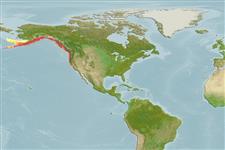Common names from other countries
>
Gadiformes (Cods) >
Gadidae (Cods and haddocks)
Etymology: Microgadus: Greek, mikros = samll + Latin, gadus = a fish, cod? (Ref. 45335); proximus: From the Latin 'proximus' meaning next (Ref. 6885).
More on author: Girard.
Environment: milieu / climate zone / depth range / distribution range
экология
морской; солоноватоводный демерсальный; мигрирует в океане (Ref. 51243); пределы глубины 0 - 275 m (Ref. 1371), usually 25 - 120 m (Ref. 1371). Temperate; 62°N - 36°N, 179°W - 121°W (Ref. 1371)
Eastern Pacific: southeastern Bering Sea to central California, USA.
Size / Вес / Возраст
Maturity: Lm ? range ? - ? cm
Max length : 30.5 cm SL самец/пол неопределен; (Ref. 27436)
колючие лучи спинного плавника (общее число) : 0; членистые (мягкие) лучи спинного плавника (общее число) : 46 - 54; колючие лучи анального плавника: 0; членистые (мягкие) лучи анального плавника: 38 - 46. Body olive green dorsally, pale ventrally; fins dusky marginally.
Generally found over sand (Ref. 1371). May enter brackish water (Ref. 1371). Young move into shallow waters in summer and fall, whereas adults usually stay in deeper waters (Ref. 28499). Feeds on shrimps, amphipods, isopods, gastropods, mussels and fishes (Ref. 1371). An important prey species (Ref. 2850).
Oviparous, sexes are separate (Ref. 205).
Cohen, D.M., T. Inada, T. Iwamoto and N. Scialabba, 1990. FAO species catalogue. Vol. 10. Gadiform fishes of the world (Order Gadiformes). An annotated and illustrated catalogue of cods, hakes, grenadiers and other gadiform fishes known to date. FAO Fish. Synop. 125(10). Rome: FAO. 442 p. (Ref. 1371)
Статус Красного Списка МСОП (Ref. 130435)
CITES (Ref. 128078)
Not Evaluated
Угроза для людей
Harmless
Использование человеком
рыболовство: не имеет хозяйственного значения; объект спортивного рыболовства: да
дополнительная информация
инструменты
Специальные отчеты
Скачать в формате XML
ресурсы в Интернет
Estimates based on models
Preferred temperature (Ref.
115969): 3.4 - 9.5, mean 5.8 (based on 253 cells).
Phylogenetic diversity index (Ref.
82804): PD
50 = 0.7500 [Uniqueness, from 0.5 = low to 2.0 = high].
Bayesian length-weight: a=0.00794 (0.00418 - 0.01508), b=3.10 (2.94 - 3.26), in cm Total Length, based on LWR estimates for this (Sub)family-body shape (Ref.
93245).
Trophic level (Ref.
69278): 3.6 ±0.59 se; based on food items.
устойчивость к внешним воздействиям (Ref.
120179): средний (среднего размера), минимальное время удвоения популяции 1.4-4.4 года (tm=2).
Fishing Vulnerability (Ref.
59153): Low to moderate vulnerability (27 of 100).
Climate Vulnerability (Ref.
125649): Moderate to high vulnerability (51 of 100).
